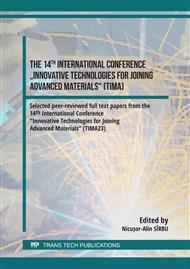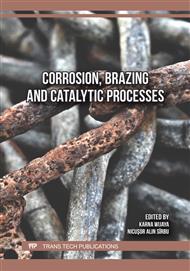p.3
p.9
p.21
p.33
p.55
p.63
p.77
p.87
Microstructural Aspects on Brazing Stainless Steels for High Temperature Applications
Abstract:
A wide range of applications request components that work in an environment where they are subject to high temperatures, combined with a corrosive action of the same environment. The components with a complex geometry can be obtained only using some assembling processes, among which are welding and brazing. One of the most important advantages of these processes is the possibility to obtain a sealed joint, that guarantees it to be waterproof. In comparison with welding process, brazing process has also an important technological advantage: it is a process that is able to produce a quality joint in a very small, narrow and tight places., where is very difficult or almost impossible to reach with other welding processes (e.g. GMAW/MIG – Gas Metal Arc Welding, GTAW/TIG – Gas Tungsten Arc Welding, SMAW – Shield Metal Arc Welding, FCAW - Flux Cored Arc Welding, SAW – Submerged Arc Welding). The research in this direction carried out in University Politehnica Timisoara, was focused on using brazing as a joining process to obtain a complex geometry part working in these environments. The brazed joint will create a dissimilar joint, putting in contact stainless steel with a Ag-Cu brazing alloy, which creates diffusion processes at microstructural level as well as phase transformations (due to thermal cycle and diffusion) which have a large impact on operating behavior of these joints. This paper presents some results on investigation phase and microstructural constituents transformations that took place in these brazed joints.
Info:
Periodical:
Pages:
9-17
Citation:
Online since:
November 2024
Authors:
Keywords:
Price:
Сopyright:
© 2024 Trans Tech Publications Ltd. All Rights Reserved
Share:
Citation:



